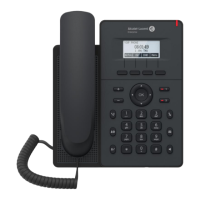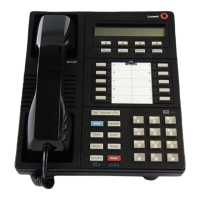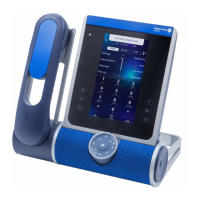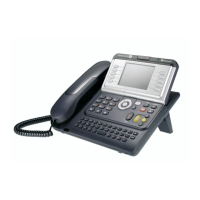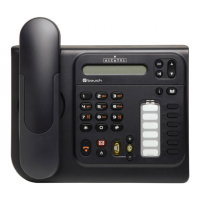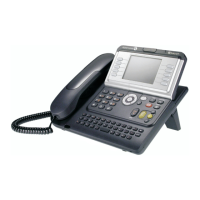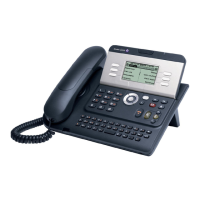Do you have a question about the Alcatel-Lucent Halo H3P and is the answer not in the manual?
Provides a brief overview of the phone user interface and its basic navigation.
Configures IP addressing modes, IPv4, and IPv6 settings for network connectivity.
Details DHCP options for IPv4 and IPv6, including specific options like 66/67, 43, and 132.
Explains VLAN configuration using LLDP, DHCP, manual settings, and Wi-Fi setup for wireless connectivity.
Describes NAT and Rport configuration, along with OpenVPN setup for secure network connections.
Configures port transmission methods and 802.1X authentication for network access control.
Guides on accessing and navigating the phone's web user interface for configuration.
Describes common CFG files and MAC-oriented CFG files for phone configuration.
Explains the role of EDS in providing information for ALE SIP devices to connect to a provision server.
Outlines manual and central provisioning methods for deploying and configuring phones.
Details methods for upgrading phone firmware via web UI, provisioning server, or USB.
Provides a step-by-step procedure for upgrading firmware using a USB drive.
Manages administrator password changes and configures the phone lock feature to prevent unauthorized use.
Details TLS protocol for secure communication, including version support and cipher suites.
Covers trusted and server certificates required for TLS handshakes and secure connections.
Describes SRTP for encrypting audio streams during VoIP calls to prevent interception.
Enables secure remote connections via SSH and configures HTTPS peer verification.
Covers configuring an AES key for encrypting and decrypting configuration files.
Manages local contacts, allowing storage of up to 1000 contacts and 50 groups.
Details LDAP configuration for accessing corporate directory servers and common attributes.
Configures access to remote phone books, allowing up to 6 remote phone books to be displayed.
Automates uploading contact files at regular intervals to a provisioning or specific server.
Configures dialing tone, stutter tone, and adjusts ringer volume levels for incoming calls.
Customizes ring tones for calls and configures distinctive ring tones based on Alert-Info headers.
Details supported audio codecs and packetization time settings for call establishment and bandwidth management.
Explains acoustic clarity features like AEC, BNS, AGC, VAD for optimized audio quality.
Describes DTMF transmission modes and suppresses DTMF digit display during calls.
Covers registering multiple SIP accounts on the phone for incoming/outgoing calls.
Details failover and fallback modes for ensuring phone service continuity.
Explains how the phone adapts to various deployment environments using DNS queries.
Manages call history and defines dial plans using character strings and regular expressions for call routing.
Configures hotline dialing, recall functionality, and sets up speed dial keys for quick dialing.
Manages anonymous calls and enables automatic answering of calls based on status.
Manages call waiting to receive new calls and configures DND to reject incoming calls.
Synchronizes DND status and configures call forwarding modes (phone/custom) for incoming calls.
Synchronizes call forward status between the IP phone and the server for various forwarding types.
Enables handling concurrent calls and manages call hold functionality, including tones and methods.
Maintains mute state across calls and enables transferring calls to a third party.
Supports local 5-way and network conference calls, with configuration options.
Sets up shared phone usage by allowing users to log in to a phone with their account.
Configures intercom functionality for quick office connections, including outgoing and incoming calls.
Manages voicemail settings and configures Busy Lamp Field (BLF) for monitoring phone status.
Allows custom services via XML browser and configures call pickup using codes for incoming calls.
Manages parking calls and retrieving them, plus feature for automatic redialing of failed calls.
Configures programmable DSS keys and soft keys for various functions like Speed Dial, DND, and Intercom.
Customizes phone wallpaper and configures screen display settings like language and screensaver.
Sets time and date manually or via NTP server, with options for time zone and DST.
Configures automatic redialing for unavailable numbers and enables call recording via USB.
Collects log files and restores the phone to factory default settings for issue resolution.
Captures network packets and performs ping/traceroute for network connectivity troubleshooting.
Provides phone reboot functionality and configures syslog for real-time logging.
Provides a brief overview of the phone user interface and its basic navigation.
Configures IP addressing modes, IPv4, and IPv6 settings for network connectivity.
Details DHCP options for IPv4 and IPv6, including specific options like 66/67, 43, and 132.
Explains VLAN configuration using LLDP, DHCP, manual settings, and Wi-Fi setup for wireless connectivity.
Describes NAT and Rport configuration, along with OpenVPN setup for secure network connections.
Configures port transmission methods and 802.1X authentication for network access control.
Guides on accessing and navigating the phone's web user interface for configuration.
Describes common CFG files and MAC-oriented CFG files for phone configuration.
Explains the role of EDS in providing information for ALE SIP devices to connect to a provision server.
Outlines manual and central provisioning methods for deploying and configuring phones.
Details methods for upgrading phone firmware via web UI, provisioning server, or USB.
Provides a step-by-step procedure for upgrading firmware using a USB drive.
Manages administrator password changes and configures the phone lock feature to prevent unauthorized use.
Details TLS protocol for secure communication, including version support and cipher suites.
Covers trusted and server certificates required for TLS handshakes and secure connections.
Describes SRTP for encrypting audio streams during VoIP calls to prevent interception.
Enables secure remote connections via SSH and configures HTTPS peer verification.
Covers configuring an AES key for encrypting and decrypting configuration files.
Manages local contacts, allowing storage of up to 1000 contacts and 50 groups.
Details LDAP configuration for accessing corporate directory servers and common attributes.
Configures access to remote phone books, allowing up to 6 remote phone books to be displayed.
Automates uploading contact files at regular intervals to a provisioning or specific server.
Configures dialing tone, stutter tone, and adjusts ringer volume levels for incoming calls.
Customizes ring tones for calls and configures distinctive ring tones based on Alert-Info headers.
Details supported audio codecs and packetization time settings for call establishment and bandwidth management.
Explains acoustic clarity features like AEC, BNS, AGC, VAD for optimized audio quality.
Describes DTMF transmission modes and suppresses DTMF digit display during calls.
Covers registering multiple SIP accounts on the phone for incoming/outgoing calls.
Details failover and fallback modes for ensuring phone service continuity.
Explains how the phone adapts to various deployment environments using DNS queries.
Manages call history and defines dial plans using character strings and regular expressions for call routing.
Configures hotline dialing, recall functionality, and sets up speed dial keys for quick dialing.
Manages anonymous calls and enables automatic answering of calls based on status.
Manages call waiting to receive new calls and configures DND to reject incoming calls.
Synchronizes DND status and configures call forwarding modes (phone/custom) for incoming calls.
Synchronizes call forward status between the IP phone and the server for various forwarding types.
Enables handling concurrent calls and manages call hold functionality, including tones and methods.
Maintains mute state across calls and enables transferring calls to a third party.
Supports local 5-way and network conference calls, with configuration options.
Sets up shared phone usage by allowing users to log in to a phone with their account.
Configures intercom functionality for quick office connections, including outgoing and incoming calls.
Manages voicemail settings and configures Busy Lamp Field (BLF) for monitoring phone status.
Allows custom services via XML browser and configures call pickup using codes for incoming calls.
Manages parking calls and retrieving them, plus feature for automatic redialing of failed calls.
Configures programmable DSS keys and soft keys for various functions like Speed Dial, DND, and Intercom.
Customizes phone wallpaper and configures screen display settings like language and screensaver.
Sets time and date manually or via NTP server, with options for time zone and DST.
Configures automatic redialing for unavailable numbers and enables call recording via USB.
Collects log files and restores the phone to factory default settings for issue resolution.
Captures network packets and performs ping/traceroute for network connectivity troubleshooting.
Provides phone reboot functionality and configures syslog for real-time logging.
| Brand | Alcatel-Lucent |
|---|---|
| Model | Halo H3P |
| Category | Telephone |
| Language | English |


